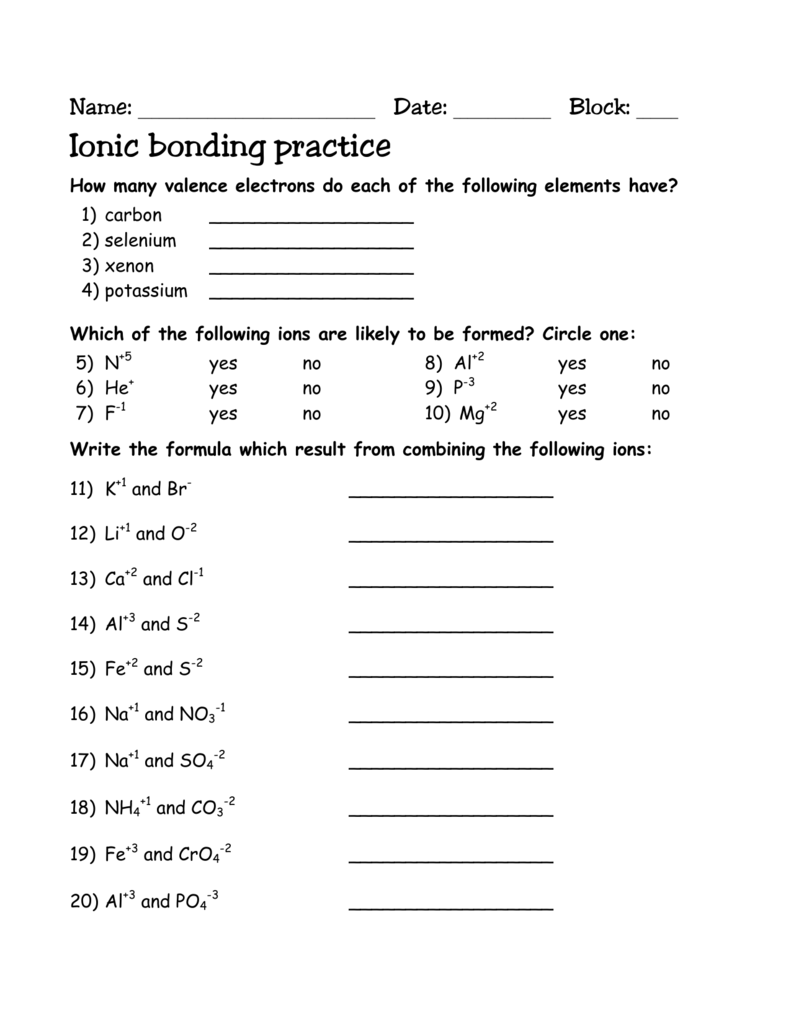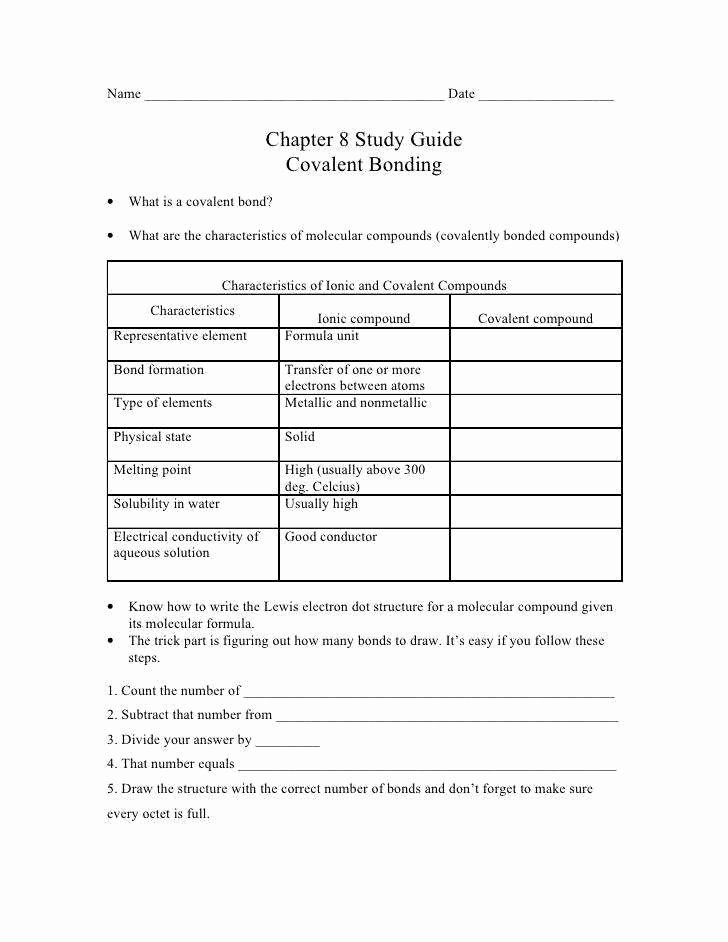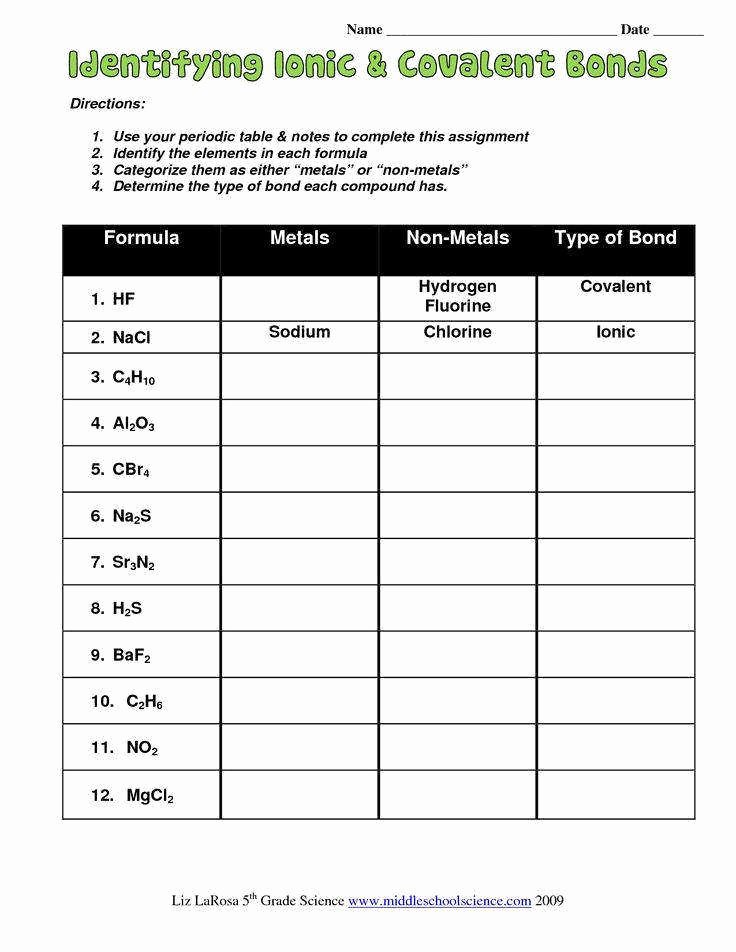Covalent Bonding Worksheet And Answers The Bonding worksheets cover covalent ionic and metallic bonding available with three levels of support scaffolded partially scaffolded and unscaffolded You will find model answers to all levels of these worksheets in the teacher guidance The Bonding worksheets cover the following topics identifying ionic covalent and metallic bonds
Use one line for each pair of electrons that is shared Write the chemical formula for each molecule Have the students use a pencil or crayon to draw the electrons as they remove the pieces of cereal Step 2 Step 1 2 Hydrogen Oxygen O Each H atom needs a total of 2 electrons to fill the outer shell H Covalent bonding occurs when two or more nonmetals share electrons attempting to attain a stable octet of electrons at least part of the time For example Note that hydrogen Is content with 2 not 8 electrons Show how covalent bonding occurs in each of the following pairs of atoms Atoms may
Covalent Bonding Worksheet And Answers

Covalent Bonding Worksheet And Answers
http://www.worksheeto.com/postpic/2009/03/ionic-and-covalent-bonding-worksheet_184565.png

Ionic Bonding Practice
https://s3.studylib.net/store/data/008417192_1-1f40e712d0b98ea77baaf4cef76e664b.png

50 Covalent Bonding Worksheet Answers
https://chessmuseum.org/wp-content/uploads/2019/10/covalent-bonding-worksheet-answers-elegant-chapter-8-covalent-bonding-worksheet-answers-breadandhearth-of-covalent-bonding-worksheet-answers.jpg
Bonding electrons 6 nonbonding electrons 20 11 Hydrogen atoms form only one covalent bond because they have only one valence electron to pair 12 Oxygen atoms form 2 covalent bonds because oxygen atoms have 6 valence electrons 2 lone pairs plus 2 unpaired electrons that are shared to achieve octet Chemical bonds are the attractive forces that hold atoms together in the form of compounds A chemical bond is formed when electrons are shared between two atoms There are three types of bonds covalent bonds polar covalent bonds and ionic bonds The simplest example of bonding is demonstrated by the H 2 molecule
Chemical bonds are the attractive forces that hold atoms together in the form of compounds A chemical bond is formed when electrons are shared between two atoms There are three types of bonds covalent bonds polar covalent bonds and ionic bonds The simplest example of bonding is demonstrated by the H 2 molecule Chapter 7 Practice Worksheet Covalent Bonds and Molecular Structure 1 How are ionic bonds and covalent bonds different Ionic bonds result from the transfer of electrons from one atom to another Covalent bonds result from two atoms sharing electrons 2 Describe the relationship between the length of a bond and the strength of that bond
More picture related to Covalent Bonding Worksheet And Answers

20 Covalent Bonding Worksheet Answers Worksheets Decoomo
https://i0.wp.com/briefencounters.ca/wp-content/uploads/2018/11/ionic-and-covalent-bonding-worksheet-answer-key-and-overview-chemical-bonds-worksheet-answers-ionic-bonding-worksheet-of-ionic-and-covalent-bonding-worksheet-answer-key.jpg?fit=768%2C994&ssl=1

50 Covalent Bonding Worksheet Answers
https://chessmuseum.org/wp-content/uploads/2019/10/covalent-bonding-worksheet-answers-unique-chemical-bonding-worksheet-of-covalent-bonding-worksheet-answers.jpg

Ionic And Covalent Bonding Worksheet
https://briefencounters.ca/wp-content/uploads/2018/11/ionic-and-covalent-bonding-worksheet-as-well-as-chemical-bonding-worksheet-key-of-ionic-and-covalent-bonding-worksheet.jpg
Model 1 Ionic Bonding The compounds formed by metals and non metals contain ionic bonds Metal atoms lose electrons to form cations Non metal atoms gain electrons to form anions The interactions between cations and anions are ionic and are often called ionic bonds Simply it is the coming together of opposite charges in a strict ratio The Covalent bonding worksheet covers the following topics interpreting diagrams representing covalent bonds sharing electrons in covalent bonds types of elements involved in covalent bonds If learners successfully answer questions on these topics they can attempt the
10 Fill in the table below to determine the molecular geometry for the following molecules Formula ABE formula Number of e domains on central atom e domains non bonding domains on central atom Electron Domain Geometry name Molecular Geometry name Bond angle s on central atom CO2 Covalent bonds can be represented in a few different ways The most common way to use a line to represent a single covalent bond In cases where there is a double or triple covalent bond as in text CO 2 or text N 2 a set of parallel lines are used with the same number of lines as there are bonds e g a triple bond is represented by three parallel lines

IGCSE Identifying Ionic Covalent Bonds Chemistry Worksheets
https://i.pinimg.com/originals/ca/b8/f5/cab8f574367db07730ac68b13af7ba2e.png

Covalent Bonding Worksheet Answer Key
https://static.docsity.com/documents_first_pages/2021/04/20/22598a994f424581bcba04ab0e1b6d24.png
Covalent Bonding Worksheet And Answers - Bonding electrons 6 nonbonding electrons 20 11 Hydrogen atoms form only one covalent bond because they have only one valence electron to pair 12 Oxygen atoms form 2 covalent bonds because oxygen atoms have 6 valence electrons 2 lone pairs plus 2 unpaired electrons that are shared to achieve octet